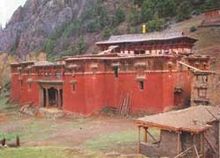Karma Gon Monastery
| Karma Gon Monastery Karma Dansa Gama Si |
|
|---|---|

Principal Hall of Karma Gon
|
|
| Coordinates | 31°58′23″N 96°42′58″E / 31.97306°N 96.71611°ECoordinates: 31°58′23″N 96°42′58″E / 31.97306°N 96.71611°E |
| Monastery information | |
| Founded by | Düsum Khyenpa |
| Date renovated | 2005 |
| Type | Tibetan Buddhist |
| Sect | Vajrayana or Mahayana |
| Lineage | Karma Kagyu |
| Number of monks | 100 |
| Architecture | Tibetan, Naxi (Jang) and Chinese |
Karma Gon Monastery, the original monastery of the Karma Kagyu sect of Tibetan Buddhism, was founded in the 12th century by Düsum Khyenpa, the 1st Karmapa Lama in eastern Tibet at the age of 76. Karma Gon (karma dgon, also Karma Dansa, karma gdan sa; Chinese, Gama Si), is located on the eastern bank of the Dzachu River in Chamdo, eastern Tibet. Karma Dansa was the cradle of the karma kagyupas. When established the Karmapa had gathered 1000 monks around him here. Karma Gon was named as Karma Dansa as an administrative unit and the Chinese Ming Court enlarged the monastery’s jurisdiction by adding the Mekong’s middle and upper reaches. It was then also called Gama Dansa Si in Chinese.
Other sources, claim it was founded in 1184 by Chödzin Gemphel(chos ‘dzin dge ‘phel), the late 1st Karmapa Düsum Khyenpa (dus gsum mkhyen pa).
History records that Deshin Shekpa, 5th Karmapa Lama gave the title of Situ to his disciple, Chokyi Gyaltsen (1377–1448), and appointed him as the Master of Studies at Karma Gon. Earlier than this incarnation, there were two others namely, Yehse Nyingpo and Ringowa Ratnabhadra. After Situ Chokyi Gyaltsen, the second Situ in the list was Tashi Namgyal (1450–97) who was ordained Thongwa Dönden, 6th Karmapa Lama and put in charge of the Karma Gon.
The third Situ was Tashi Paljor (1498–1541) followed by the Situ Chokyi Gocha (1542–85); both were involved in developing the Karma Gon Monastery. They are credited with creating a fine library, apart from embellishing the monastery walls with rare paintings and carvings. Most of these were reportedly destroyed during the Cultural Revolution by the communist regime, except for a few old buildings that still remain. The fourth Situpa was Situ Tashi Paljor who identified Miko Dorjee as the 8th Karmapa and who also became his teacher. The Fifth Situpa Chokyi Gyaltsen was honoured with a red Crown by Wangchuk Dorje, 9th Karmapa Lama for his spiritual attainments. The Tai Situpas with their roots in the Kham region of eastern Tibet always played a significant role in identifying the Karmapa Incarnations. The sixth Tai Situpa was Mipal Chogyal Rabten (1658–82) known for his miracle performing achievements, who was followed by Mawe Nyima (son of King Lin) who had a premature death. The eighth Tai Situpa, Chokyi Jungne (1700–74) was the most distinguished scholar who went to establish Palpung Monastery in 1717 after which the importance of the Karma Gon monastery has waned.
...
Wikipedia
